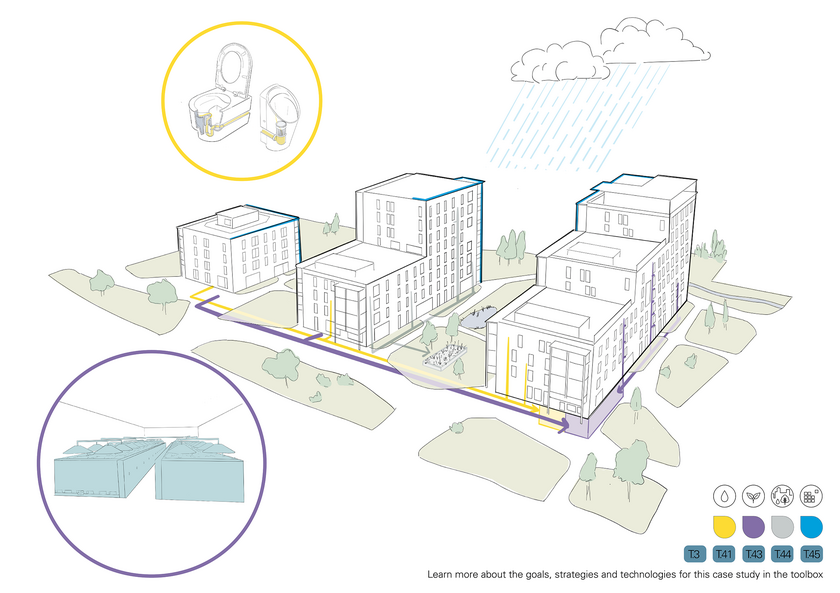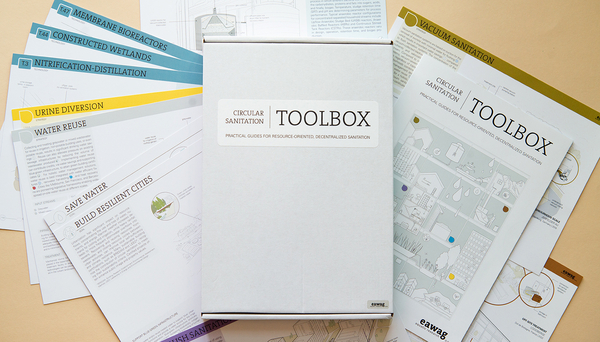News Detail
Toolbox for planning decentralised sanitation systems
November 18, 2025 |
A push of a button, flush and away – that’s how toilets usually work in Switzerland. Most of what is flushed away here, together with wastewater from kitchens, washing machines and showers, ends up in centralised wastewater treatment plants via the sewer system, where it is treated and then discharged into a body of water. The development of the necessary infrastructure from the 1960s onwards brought great benefits for human health and water protection. Nonetheless, a downside of centralised treatment is that urine and faeces are mixed and diluted with large amounts of flushing water, other domestic wastewater as well as stormwater in the sewer system. This makes it more challenging to recover nutrients, organics, energy and water for reuse.
The aquatic research institute Eawag is therefore not only working on optimising centralised wastewater treatment but also advancing decentralised systems. These involve separating the various waste(water) streams at their source, treating them on site or nearby, and recovering resources such as clean water, nutrients and energy. Hybrid forms involving both centralised and decentralised solutions and combinations with dry toilets that do not require flushing water are also possible.
Such systems are already established in many places around the world – whether because water is scarce, there are no sewer systems or people want to recover resources. Interest in decentralised solutions is also growing in Switzerland and Europe. However, anyone interested in resource oriented and decentralised sanitation and wastewater systems can find it difficult to obtain an overview of the possible technical solutions.
World Toilet Day 2025
19 November 2025 is World Toilet Day. The topic of this year's United Nations campaign is “Sanitation in a changing world”. It aims to draw attention to the urgent need for investment in safe and sustainable sanitation in view of ageing wastewater infrastructure and climate change.
The new toolbox developed by a team from Eawag’s Process Engineering Department is now closing this gap. Besides an introduction to the topic, it provides architects, planners and others interested in the subject with guidance on defining the objectives that they wish to pursue with the decentralised solution as well as the strategy they can apply. Individual sheets present the technologies that are available depending on the goals and strategy. In addition, implementation examples are given, ranging from solutions for individual households to those for entire neighbourhoods, in both urban and rural areas. The toolbox thus provides a practical overview of the possibilities for decentralised sanitation and wastewater systems.
Five questions for the toolbox developers
Ms Wielemaker, Mr Morgenroth, why did you develop the toolbox?
Rosanne Wielemaker: The toolbox is a guide for planning a building with decentralised, resource-oriented wastewater solutions. Often, at the beginning of the planning process, there is a lack of knowledge about the possibilities in this area. This means that property developers and architects tend to focus primarily on what already exists.
Eberhard Morgenroth: The toolbox is designed to show practitioners what is possible in this area – what goals they could set for a construction project, what strategies they can use to achieve these goals, and what technologies they can use to do so. They can then specifically search for an engineering firm or a provider to help them realise the project and ask them the right questions.
RW: This is why the toolbox is structured in the form of individual sheets. It allows planners to mix and match goals, strategies and technologies in meetings together with their stakeholders.
You have only included technologies in the toolbox that are already being used in buildings or settlements. You present some of these buildings as examples in the toolbox.
EM: Yes, these case studies help to illustrate practical implementation with related costs, energy and space requirements. As these vary greatly depending on the building, we chose not to provide general, quantitative information for these important aspects in the toolbox.

You have not only developed the toolbox for Switzerland, but also for international use. The case studies therefore come from all over the world. Can all these technologies already be implemented under the legal framework in Switzerland?
EM: Yes, most of these technologies can be implemented in Switzerland and already are – many of them are even available off the shelf. Although every building in Switzerland must be connected to the sewer system, decentralised solutions can still be implemented. However, it is not yet permitted to use treated wastewater from your own household to water your garden. And there are still no legal regulations in place for some technologies.
RW: So once planners have familiarised themselves with the various options using the toolbox, the next step is to find out about the laws and regulations in their region. In this regard, the case studies can also serve as inspiration for policymakers by showing them what is possible in other parts of the world.
How does quality control work for decentralised wastewater treatment solutions and who is responsible in the event of malfunctions?
EM: In the case of water reuse at the household scale, there is, for example, the NSF 350 certificate – a seal of quality from the US National Sanitation Foundation. It ensures that the technologies have been thoroughly tested and are sufficiently robust.
More complex systems in larger buildings or settlements are installed and subsequently maintained by specialised companies. This means that these companies use remote monitoring to ensure that the system is working and that any malfunctions are quickly rectified.

Where could decentralised sanitation and wastewater solutions be a good alternative to centralised wastewater disposal in Switzerland in the future?
RW: The most obvious need is, of course, in remote rural locations or in SAC huts, where decentralised systems can be used for wastewater treatment. In general, decentralised systems are of interest in areas where the cost of connecting to the sewer system would be disproportionately high.
EM: In addition to solutions that function completely without a connection to the sewer system, there are also hybrid solutions. Here you have a connection to the sewer system but use decentralised wastewater treatment to reduce water consumption or recover nutrients. These are aspects that are also included in some international standards for sustainable construction, such as LEED or BREEAM, because they reduce the ecological footprint of a building.
RW: I am convinced that interest in alternative solutions will also increase in Switzerland. This is because the challenges – water scarcity, ageing and overloaded wastewater infrastructures – are also growing.
EM: The toolbox is designed to support this development, because innovation will require architects who have an overview of available technologies and approaches for system integration. It requires regulatory authorities that understand the impact these technologies have. It requires companies that can see where their niche in this market might lie. And it requires engineers who conduct research where there are still gaps.
RW: And the structure of the toolbox as individual sheets allows each of these practitioners to pick and choose the topics relevant for their needs. It also allows us to add more guides as new technologies are developed and implemented.
Cover picture: The toolbox contains three sets of individual sheets that help with planning decentralised wastewater solutions – from defining goals and selecting a strategy to providing an overview of possible technologies. (Photo: Eawag, Peter Penicka)

